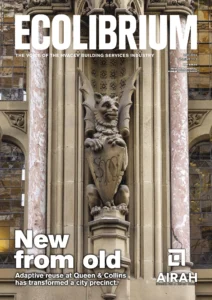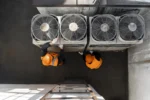Carbon coordination

The race is on to reduce embodied carbon in buildings and construction. But as more organisations take up the challenge, coordination is key.
Embodied carbon is a hot topic in the built environment. In a nutshell: as the grid decarbonises, operational emissions from buildings shrink; the emissions from producing construction materials and equipment do not.
According to the GBCA report Embodied Carbon & Embodied Energy in Australia’s Buildings, without action, embodied carbon will be responsible for 85 per cent of Australia’s built environment emissions by 2050. Indeed, countries such as Canada, Sweden, and Norway are already seeing an almost 50/50 embodied carbon versus operating carbon split.
A crowded space
Many groups are working hard on the embodied carbon challenge. This includes AIRAH, bringing the perspective of the HVAC&R sector. Building services represents about 15 per cent of the up-front embodied carbon in a commercial building, and almost 30 per cent when you factor in the replacement of parts and equipment over the building’s life.
One risk of having so many organisations working on the problem, is fragmentation –different groups may do the same work and come up with conflicting solutions. Collaboration is crucial.
On March 22, AIRAH attended a workshop at the University of Melbourne organised by the Decarbonising Building Industry (DBI) initiative. The DBI network unites researchers, industry experts and policymakers to share knowledge and explore best practices that will pave the way to energy-efficient buildings. The latest event focused on embodied carbon.
Head of Product Development at NABERS James Elks spoke about the development of the NABERS Embodied Carbon tool, due to be launched in June.
Driving change
MECLA Chair Hudson Worsley spoke about how his program is driving change in material supply chains by demonstrating demand for low-embodied-carbon products, defining best practice for measuring embodied carbon, knowledge sharing, developing consistent language, and helping to manage climate transition risks.
GBCA Senior Manager Policy and Government Relations Shay Singh spoke about working with ASBEC and the Property Council of Australia on the Every Building Counts policy platform, and how the new Green Star Buildings rating tool incorporates embodied carbon.
To complete the picture, ASBEC Executive Director Alison Scotland and Mansfield Advisory Director Jeremy Mansfield OAM spoke about ASBEC’s embodied carbon reduction project. The team plans to release an issues paper mid-year and a comprehensive policy framework in October.
Acknowledging the variety of groups working on the issue, Scotland emphasised that although embodied carbon exists in a competitive world, cooperation and consistency are vital.
Building confidence
DBI Deputy Network Convenor Dr Behzad Rismanchi, M.AIRAH, says the event aimed to foster collaboration to overcome barriers to decarbonisation – such as industry inertia around new materials and products.
“We know that the technology is out there,” he says, “we just need to adopt it. But we also know that industry is very risk averse.”
Dr Rismanchi says that even when new technology is included in a request for quote (RFQ), it often falls out of the project.
“We want to have builders, contractors, consultants and researchers sitting around the table and talking,” he says, “and being able to convince each other that there’s not much risk of using what is being used already in other parts of the world.”
When asked what the DBI initiative will add to the very active embodied carbon conversation, Dr Rismanchi says he hopes it can act as a facilitator.
“At the moment we believe there is a gap between people,” he says. “They’re not talking with each other as much as they should do.”
Putting a price on carbon
During the workshopping section of the event, participants spoke of the need to place a value or price on carbon. One speaker suggested that if a company chose to knock down a building before the end of its useful life, they should pay for the carbon that had been wasted.
“Carbon cost, or a carbon tax – we had it before, we just got rid of it,” says Dr Rismanchi. “There is a tango between what is needed and what the policy and government is pushing forward. We cannot change the way the government thinks, but we can shine a light on it.”
AIRAH is member of MECLA and is participating in the ASBEC embodied carbon reduction project.
Feature photo from left to right: Dr Behzad Rismanchi, M.AIRAH, Hudson Worsley, Shay Singh, Jeremy Mansfield OAM, Alison Scotland and Tuan Ngo.

This article appears in Ecolibrium’s May 2024 edition
View the archive of previous editions
Latest edition
See everything from the latest edition of Ecolibrium, AIRAH’s official journal.




